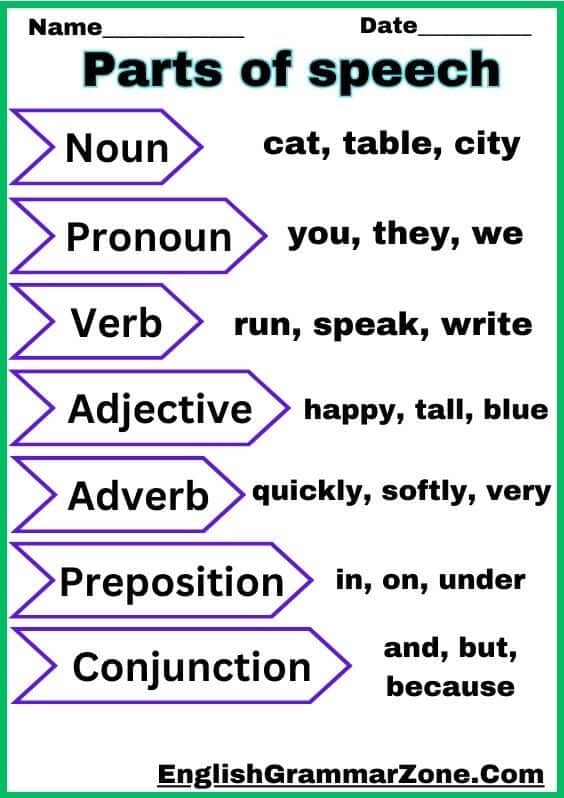Understanding the Parts of Speech Definition Types is a fundamental aspect of mastering the English language. Whether you’re learning English as a second language or refining your grammar skills, knowing how words function within sentences is key to clear and effective communication. The parts of speech help us identify the role each word plays in a sentence, allowing us to construct meaningful and grammatically correct statements. In this guide, we will break down the parts of speech definition, explain each type in simple terms, and offer practical examples to make it easier to grasp. By the end of this article, you will have a better understanding of how different words work together to create proper sentences.
Parts of Speech Definition Types
-
Noun
cat, table, city
- Pronoun
you, they, we
- Verb
run, speak, write
- Adjective
happy, tall, blue
- Adverb
quickly, softly, very
- Preposition
in, on, under
- Conjunction
and, but, because
- Interjection
wow, ouch, hooray

Parts of Speech Definition Types & Examples
Noun
A noun is a word that names a person, place, thing, or idea.
Types:
- Common Nouns: General names for things (e.g., dog, city, book).
- Proper Nouns: Specific names for people, places, or organizations (e.g., Sarah, Paris, Microsoft).
- Abstract Nouns: Names for things that cannot be seen or touched (e.g., love, freedom, courage).
- Concrete Nouns: Names for things that can be seen or touched (e.g., apple, car, house).
Examples:
- Person: teacher, student
- Place: park, school
- Thing: computer, chair
- Idea: happiness, knowledge
- Pronoun
A pronoun is a word that takes the place of a noun.
Types:
- Personal pronouns: refer to specific people or things (e.g., I, you, he, she).
- Possessive Pronouns: Show ownership (e.g., my, your, his, her).
- Reflexive Pronouns: Refer back to the subject of the sentence (e.g., myself, yourself, himself).
- Demonstrative Pronouns: Point to specific things (e.g., this, that, these, those).
- Relative Pronouns: Connect clauses and refer to nouns (e.g., who, whom, which, that).
Examples:
- Personal: she, we
- Possessive: theirs, ours
- Reflexive: himself, ourselves
- Demonstrative: this, those
- Relative: who, which
- Verb
A verb is a word that expresses an action or a state of being.
Types:
- Action Verbs: Describe actions (e.g., run, eat, sing).
- Linking Verbs: Connect the subject to a subject complement (e.g., am, is, are, was, were).
- Auxiliary Verbs (Helping Verbs): Help the main verb (e.g., have, will, should).
Examples:
- Action: jump, write
- Linking: appear, seem
- Auxiliary: will, have
- Adjective
An adjective is a word that describes or modifies a noun or pronoun.
Types:
- Descriptive Adjectives: Provide details about the noun (e.g., colorful, tall).
- Quantitative Adjectives: Indicate quantity (e.g., few, many).
- Demonstrative Adjectives: Point out specific nouns (e.g., this, those).
- Possessive Adjectives: Show ownership (e.g., my, your).
Examples:
- Descriptive: beautiful, large
- Quantitative: several, few
- Demonstrative: that, these
- Possessive: his, our
- Adverb
An adverb is a word that modifies a verb, an adjective, or another adverb.
Types:
- Manner Adverbs: Describe how something is done (e.g., quickly, softly).
- Place Adverbs: Describe where something happens (e.g., here, there).
- Time Adverbs: Describe when something happens (e.g., now, yesterday).
- Frequency Adverbs: Describe how often something happens (e.g., always, seldom).
Examples:
- Manner: well, carefully
- Place: upstairs, nowhere
- Time: soon, recently
- Frequency: often, rarely
- Preposition
A preposition is a word that shows the relationship between a noun or pronoun and other words in a sentence.
Types:
- Simple Prepositions: One-word prepositions (e.g., in, on, at).
- Complex Prepositions: Prepositions made up of multiple words (e.g., in front of, next to).
Examples:
- Simple: under, over
- Complex: beside the chair, in front of the house
- Conjunction
A conjunction is a word that connects words, phrases, or clauses.
Types:
- Coordinating Conjunctions: Connect words, phrases, or independent clauses (e.g., and, but, or).
- Subordinating Conjunctions: Connect an independent clause with a dependent clause (e.g., because, although).
- Correlative Conjunctions: Work in pairs to connect elements (e.g., either/or, neither/nor).
Examples:
- Coordinating: and, but
- Subordinating: if, since
- Correlative: either…or, neither… nor
- Interjection
An interjection is a word or phrase that expresses a strong emotion or reaction.
Types:
- Exclamatory Interjections: Show strong feelings (e.g., wow, ouch).
- Mild Interjections: Express less intense feelings or reactions (e.g., oh, well).
Examples:
- Exclamatory: hooray, yikes
- Mild: hmm, oh
Read More
1. List Of Possessive Pronoun With Example Worksheet
2. 120 Examples of declarative sentence in English

